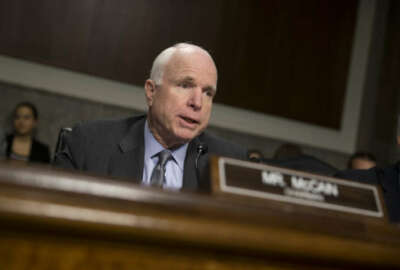
HASC chairman: $640B NDAA draft ‘does a lot more’ than Trump’s budget
Rep. Mac Thornberry’s (R-Texas) said his draft version of the defense authorization bill includes a pay raise for military members and increased missile defense...
A foot on the accelerator and change in tempo is how House Armed Services Committee Chairman Mac Thornberry (R-Texas) describes his chamber’s version of the developing 2018 Defense authorization bill.
Speaking to reporters Thursday, Thornberry said his draft of the $640 billion National Defense Authorization Act includes a 2.4 percent pay raise for military members, reforms Defense acquisition, and emphasizes a stronger and more permanent overseas presence.
The “chairman’s mark” omits DoD’s request for another round of Base Realignment and Closure [BRAC], but Thornberry said he was not necessarily opposed to one if there is data to justify it.
“Obviously a big part of this mark, including the unfunded requirements, will be readiness,” Thornberry said. “Whether it’s depots, whether it’s maintenance, whether it’s any aspect of trying to get planes that fly, ships that sail, vehicles that can actually roll down the road.”
The chairman’s initial draft of the massive Defense bill will serve as a springboard for the annual, hours-long markup session in the House Armed Services Committee next Wednesday, when the full panel debate individual provisions and offer amendments.
President Donald Trump requested $603 billion in his 2018 Defense budget request, and a 2.1 percent pay raise. Like administrations before it, the Trump administration proposed a lower pay raise than would otherwise occur under a formula tied to the Employment Cost Index in order to save money — $200 billion during 2018.
“There are conversations that are going on to see whether the budget committee, and our committee and the defense appropriations committee, can be on the same line,” Thornberry said of the $640 billion base spending amount. “It is possible between now and tomorrow, now and next week, there could be some adjustment to that number.”
Thornberry said he would agree to a lower number if there is “some future stability, future funding, future predictability, that shows me a path we don’t have to do this year after year. That is of value to me.”
“I think [$640 billion] is what we need to address the problems that have developed from sequestration and the pace, the tempo of operations over the years,” Thornberry said, adding that the upcoming conversations will not just be about FY18, but 2019 and 2020 and beyond.
Neither proposal includes the additional $65 billion that each would spend for overseas contingency operations.
Asked about squaring the White House’s lower budget number with the president’s promises to strengthen the military and boost defense spending , Thornberry pointed to the fact that when the budget came out in late May, there were only two Trump-nominated and Senate-confirmed appointees at DoD.
“This is an Obama budget request, because there wasn’t anybody at DoD to write a Trump budget request,” Thornberry said. “I have no doubt that the president is very committed to rebuilding the military and repairing the damage. I think our budget does a lot more of that than the budget that OMB sent over, admittedly, without any Trump-confirmed people in the Pentagon to provide input to it.”
ERI and acquisition
Thornberry said the draft NDAA moves funding for the European Deterrence Initiative [previously the European Reassurance Initiative] from OCO to the baseline budget.
“I’m trying to, slowly, as best I can, make OCO about OCO,” Thornberry said. “But in addition I think it sends a clear signal to allies and adversaries alike, that we’re there to stay.”
The bill does require a report on what a permanent eastern European presence would require, Thornberry added, and also includes provisions on an “ERI for the Pacific.”
Thornberry said the NDAA draft includes changes to his third annual bill reforming the defense acquisition system. He said the bill received a number of comments and feedback and pushback, and one of the biggest changes was the wording in the e-commerce section.
The fear, Thornberry said, was that the way the legislation was originally worded could lead to an Amazon-only monopoly.
“The goal is to have multiple online marketplaces,” Thornberry said. “We changed the wording of the language to better reflect the desire and expectation that it will be more than one.”
The congressman said his team also worked with the House Committee on Oversight and Government Reform to flesh out that acquisition style governmentwide.
“We’ve talked a lot with GSA, who’s very interested in helping manage these online marketing places for the benefit of the entire government, and I think … all parts of the government will get a better deal when you make the buying community bigger than DoD,” Thornberry said.
Munitions and missile defense
Thornberry said the chairman’s version of NDAA will “try to put the foot to the gas pedal” on missile defense, and other areas that would see an increase in support are cyber — both in dollars and congressional oversight — and munitions.
“To their credit, the administration’s budget request did have more money for munitions, but not nearly what they could or should have in my view,” Thornberry said. “I am still somewhat astonished that the administration’s request actually cuts missile defense by $340 million from what we are spending this year.”
Copyright © 2025 Federal News Network. All rights reserved. This website is not intended for users located within the European Economic Area.
Related Stories





